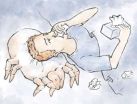(Press-News.org) If you're a member of the Clean Plate Club – you eat pretty much everything you put on your plate – you're not alone! A new Cornell University study shows that the average adult eats 92% of whatever he or she puts on his or her plate. "If you put it on your plate, it's going into your stomach," says Brian Wansink Ph.D., author of the forthcoming book, Slim by Design, Professor of Marketing and Director of the Cornell Food and Brand Lab.
Wansink and co-author Katherine Abowd Johnson analyzed 1179 diners and concluded that we're a Clean Plate Planet. Although diners were analyzed in 8 developed countries, the US, Canada, France, Taiwan, Korea, Finland, and the Netherlands, the results were nearly identical. If we serve it, we'll eat it regardless of gender or nationality. "Part of why we finish most of what we serve is because we are aware enough to know how much we'll want in the first place," says Johnson.
The finding did not hold true with children. Analysis of 326 participants under 18 years old, showed that the average child eats only 59% of what he or she serves. "This might be because kids are less certain about whether they will like a particular food," says Wansink. "Regardless, this is good news for parents who are frustrated that their kids don't clean their plate. It appears few of them do."
Wansink says that these findings, published in the International Journal of Obesity, can positively impact an individual's eating behavior, "Just knowing that you're likely to consume almost all of what you serve yourself can help you be more mindful of appropriate portion size." Next time you grab that serving spoon, think to yourself, "How much do I want to eat?" and serve accordingly.
INFORMATION:
For more information visit: http://foodpsychology.cornell.edu/op/Clean_Plate_Club#
The 92 percent clean plate club
Most of the world belongs to the clean plate club -- except children
2014-07-22
ELSE PRESS RELEASES FROM THIS DATE:
Essays in English yield information about other languages
2014-07-22
Computer scientists at MIT and Israel's Technion have discovered an unexpected source of information about the world's languages: the habits of native speakers of those languages when writing in English.
The work could enable computers chewing through relatively accessible documents to approximate data that might take trained linguists months in the field to collect. But that data could in turn lead to better computational tools.
"These [linguistic] features that our system is learning are of course, on one hand, of nice theoretical interest for linguists," says Boris ...
NASA's Fermi finds a 'Transformer' pulsar
2014-07-22
VIDEO:
Zoom into an artist's rendering of AY Sextantis, a binary star system whose pulsar switched from radio emissions to high-energy gamma rays in 2013. This transition likely means the pulsar's...
Click here for more information.
In late June 2013, an exceptional binary containing a rapidly spinning neutron star underwent a dramatic change in behavior never before observed. The pulsar's radio beacon vanished, while at the same time the system brightened fivefold in gamma rays, ...
Forty-five percent rise in diagnostic imaging tests by GPs -- new study
2014-07-22
A 45 per cent rise in diagnostic imaging tests ordered by Australian GPs is being driven by increasing GP visits, a rising number of problems managed at consultations and a higher likelihood that GPs order imaging tests for these problems, according to a new University of Sydney study released today.
Based on a long term national survey of 9,802 GPs between 2002 and 2012, the report draws on data from more than 980,000 GP-patient encounter records to assess the extent to which GP's order tests in line with diagnostic imaging guidelines.
"Most imaging tests ordered by ...
Gene variant identified as a heart disease risk factor for women
2014-07-22
When it comes to heart disease, Dr. Ross Feldman says women are often in the dark. Historically, it was thought that heart disease was a men's-only disease, however, data has shown that post-menopausal women are just as likely as men to get heart disease and are less likely to be adequately diagnosed and treated. New research from Western University published online this week in the British Journal of Clinical Pharmacology brings to light a genetic basis for heart disease in women and helps to identify which women are more prone to heart disease.
The study, led by Dr. ...
Researchers create vaccine for dust-mite allergies
2014-07-22
If you're allergic to dust mites (and chances are you are), help may be on the way.
Researchers at the University of Iowa have developed a vaccine that can combat dust-mite allergies by naturally switching the body's immune response. In animal tests, the nano-sized vaccine package lowered lung inflammation by 83 percent despite repeated exposure to the allergens, according to the paper, published in the AAPS (American Association of Pharmaceutical Scientists) Journal. One big reason why it works, the researchers contend, is because the vaccine package contains a booster ...
Activity level may predict orthopedic outcomes
2014-07-22
According to a literature review in the July issue of the Journal of the American Academy of Orthopaedic Surgeons (JAAOS), patients' activity level is a strong predictor for how well they will do with certain treatments and how well they recover from injuries after treatment. Patients are encouraged to ask their orthopaedic surgeon if activity level is an important factor in their treatment decision. For example, more active patients are at a higher risk of re-injury after an anterior cruciate ligament (ACL) reconstruction, and activity level should be considered when deciding ...
UI study finds potential genetic link between epilepsy and neurodegenerative disorders
2014-07-22
A recent scientific discovery showed that mutations in prickle genes cause epilepsy, which in humans is a brain disorder characterized by repeated seizures over time. However, the mechanism responsible for generating prickle-associated seizures was unknown.
A new University of Iowa study, published online July 14 in the Proceedings of the National Academy of Sciences, reveals a novel pathway in the pathophysiology of epilepsy. UI researchers have identified the basic cellular mechanism that goes awry in prickle mutant flies, leading to the epilepsy-like seizures.
"This ...
Death of a parent during childhood is associated with greater mortality in early adulthood
2014-07-22
Experiencing the loss of a parent during childhood or adolescence is associated with a greater risk of mortality, according to a study published in this week's PLOS Medicine. The study, conducted by Jiong Li and colleagues from Aarhus University in Denmark, finds that individuals who lost either a mother or a father during childhood had a greater risk of mortality in the years following the parent's death compared with people unaffected by parental death during childhood.
The researchers reached these conclusions combining data from national registries from all children ...
Distinctive developmental origin for a drainage tube in the eye
2014-07-22
A Jackson Laboratory based research team has conducted a comprehensive exploration of an eye structure known as Schlemm's canal: a key gatekeeper for the proper flow of eye fluid, presenting a number of insights relevant to glaucoma and other diseases.
For the study publishing July 22 in the Open Access journal PLOS Biology, the researchers at JAX and Tufts University School of Medicine in Boston developed a new, "whole-mount," three-dimensional approach to analyse mouse models that have been engineered to host fluorescent proteins, to determine how Schlemm's canal forms ...
New research finds pathogenic connection between autoimmune disorders and cancer
2014-07-22
WASHINGTON -- Autoimmune disorders may share certain pathogenic mechanisms with cancer, according to a new report by George Washington University (GW) researcher Linda Kusner, Ph.D., published in PLOS ONE on July 22.
This paradigm shifting work shows that the very same inhibitors of apoptosis, or cell destruction, in tumors are also expressed in cells that produce autoimmune diseases. Henry Kaminski, M.D., chair of the Department of Neurology at the GW School of Medicine and Health Sciences (SMHS), as well as colleagues from the Roswell Park Cancer Institute, collaborated ...
LAST 30 PRESS RELEASES:
Exercise might help improve mobility during aging
New online tool detects drug exposure directly from patient samples
Learn the surprising culprit limiting the abundance of Earth’s largest land animals
Study reveals new ways the brain regulates communication between neurons
Research reveals new hybrid state of matter where solids meet liquids
Researchers develop a new computational tool to understand how genetic interactions impact human traits
Elephants, giraffes and rhinos go where the salt is
Cancer loses its sense of time to avoid stress responses
The twisted nanotubes that tell a story
Flaring black hole whips up ultra-fast winds
Study explores the link between newspaper preference and attitudes towards autism
Artificial turf in the Nordic climate – a question of sustainability
The hidden toll of substance use disorder: annual cost of lost productivity to US economy nearly $93 billion
Among psychologists, AI use is up, but so are concerns
Recycling a pollutant to make ammonia production greener
Common institutional ownership linked to less aggressive business strategies in Chinese firms
Energy and regional factors drive carbon price volatility in China’s emissions trading markets
Researchers from NUS Medicine and the Institute of Mental Health detect early brain changes linked to future psychosis development
Cryopreserved vs liquid-stored platelets for the treatment of surgical bleeding
Cost-effectiveness of cryopreserved vs liquid-stored platelets for managing surgical bleeding
Adaptive Kalman filter boosts BDS-3 navigation accuracy in challenging environments
Home-based monitoring could transform care for patients receiving T-cell redirecting therapies
Listening to the 'whispers' of electrons and crystals: A quantum discovery
Report on academic exchange (colloquium) with Mapua University
Sport in middle childhood can breed respect for authority in adolescence
From novel therapies to first-in-human trials, City of Hope advances blood cancer care at the American Society of Hematology (ASH) annual conference
Research aims to strengthen the security of in-person voting machines
New study exposes hidden Alzheimer’s 'hot spots' in rural Maryland and what they reveal about America’s growing healthcare divide
ASH 2025: Study connects Agent Orange exposure to earlier and more severe cases of myelodysplastic syndrome
ASH 2025: New data highlights promise of pivekimab sunirine in two aggressive blood cancers
[Press-News.org] The 92 percent clean plate clubMost of the world belongs to the clean plate club -- except children


